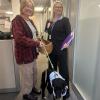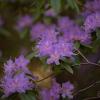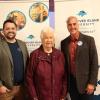February 4, 2008 - 6:42am
In Dublin's fair city where the girls are so pretty
I first set my eyes on sweet Molly Malone
She wheeled her wheelbarrow through streets broad and narrow
Calling "Cockles and Mussels - Alive-Alive-Oh!"
Alive-Alive-Oh! Alive-Alive-Oh!
Calling "Cockles and Mussels - Alive-Alive-Oh!"
With a famous Irish folk song for marketing and a team of leading researchers on the job, can it be long before BC shellfish farmers have a tasty new product to offer? Research scientists from the Malaspina University-College Centre for Shellfish Research (CSR) and the Marine Ecosystems and Aquaculture Division of DFO have teamed up with industry and First Nations to undertake the development of the native cockle, Clinocardium nuttalii.
“Native cockles are found from California to Alaska and grow on the lower intertidal area of sand and mud beaches around the 1-3 foot tide level” says Don Tillapaugh, Director of the CSR. “They are bivalve molluscs (like clams) and have very attractive shells with pronounced ridges. A First Nations Elder once told me that aboriginal people have prized cockles for centuries as a preferred food from ‘Mother Nature’s refrigerator’. I really don’t have a good explanation of why cockles have not been grown as an aquaculture species in the past in BC, but there is genuine commercial and First Nations interest now as demand increases for sustainable seafood products” says Tillapaugh.
Tillapaugh goes on to explain that “developing a new aquaculture species is a multi-faceted process. We have assembled a research advisory committee consisting of shellfish farmers and shellfish scientists and we are undertaking the development of this new species in a systematic and collaborative way – making the best use of everyone’s expertise and funding”.
“We began by investigating the conditions required to get the parents (broodstock) to spawn” explains Dr. Wenshan Liu of the CSR. “Cockles are ‘hermaphroditic’ – meaning that each adult has both male and female reproductive organs and produces both eggs and sperm. This presented some unique challenges for us in our first experiment where we were trying to obtain the best fertilization rates” said Dr. Liu.
After fertilization, cockles have a “larval” phase where they float in the water for a 2-3 week period; they then change form (metamorphose) into tiny cockle seed about one quarter of a millimeter in size and settle onto the bottom. Dr. Chris Pearce of DFO says “we are now investigating how many larvae and juvenile seed to raise in each hatchery tank and what is the best water temperature and natural feed (phytoplankton) to promote the fastest growth and highest survival in the hatchery. Our research is progressing very well and we are finding that cockles are very happy in our hatchery system”.
“Because developing a new species is a very expensive proposition, and often beyond the reach of an individual company, the CSR’s Mission is to undertake this type of research on behalf of the entire BC shellfish industry” explains Tillapaugh. “We have the facilities and equipment to undertake the cockle research program, however, we rely on funding from DFO’s Aquaculture Collaborative Research and Development Program (ACRDP) to make it happen. The ACRDP program is a perfect fit for funding this type of systematic research program for new species development. By working together in a strategic partnership we can make maximum use of scarce research dollars and bring a new species to market in the least amount of time”.
Tillapaugh goes on to say that one final stage of the research program remains and that is to determine the best methods of growing cockles in the ocean. “This is where our shellfish industry partners come in” says Dr. Pearce. “They have the sites, culture equipment, and farming knowledge, while we will provide the scientific expertise and monitoring. Hopefully, with further funding support and the continued success and cooperation of all our partners, we could have a new aquaculture species developed within two more years – a phenomenally short amount of time. This is what research collaboration is all about.”
Tags: In the Community






